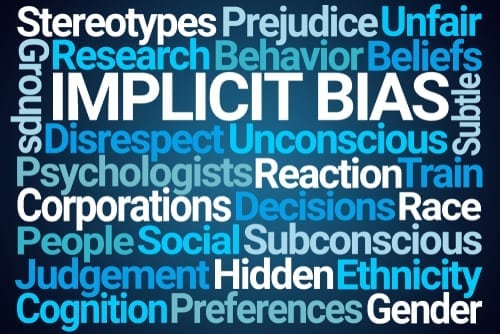The attorneys at Gignilliat, Savitz, & Bettis, LLP represent South Carolina businesses in a variety of situations, including preventing and resolving employment issues. While this journal frequently focuses on legal issues that affect the workplace and could open employers to liability to their employees, employers are responsible for more than just their employees. Employers may be responsible to third parties (think customers, clients, and the general public) for actions that their employees take. Fairly recently, the issue of unconscious bias arose when two African American men who were in a Starbucks in Philadelphia were arrested simply for waiting in the café. As a result of the incident, Starbucks closed 8,000 locations for four hours to train its 175,000 employees on racial bias on May 29, 2018. Starbucks is not the first company to address bias in its ranks. In 2014, Google released staggering diversity statistics that showed 70% of its employees were men, just 3% were Latino, and only 2% were African American. This journal entry will discuss implicit bias (also called unconscious bias) and detail how it affects the workplace and companies.
What Is Implicit Bias?
Bias is an inclination in favor of or against a thing, person, or group compared with another, usually in a way considered to be unfair. Biases may be preconceived or unreasoned. Prejudice is an unjustified or incorrect negative attitude towards a person based solely on the person’s membership of a group (race, age, weight, gender, religion, etc.). Generally, employers are aware of the concepts of prejudice and bias and the need to be unprejudiced and unbiased in making employment decisions.
We use unconscious or implicit cognitions all the time for routine activities like walking or driving. That is, we react to information we perceive without even thinking about it. (For example, you may slow down your car when pedestrians are close by giving it any thought.) Implicit social bias happens when a person makes those same judgments or assessments of a person or people without realizing it. Implicit bias occurs automatically and is triggered by our brain making quick judgments of people. Our unconscious biases are often influenced by our background, personal experiences, and cultural environment. These subconscious attitudes can still span race, appearance, age, or gender. Unconscious bias can permeate a company’s hiring practices, employee review practices, and business culture and may affect how its employees interact with customers and clients. It is particularly difficult to address or respond to because it is largely unacknowledged by those who hold the bias.
There are various types of unconscious bias that can affect your employment processes or your relationships with your customers:
- Conformity bias is caused by group peer pressure. This can affect decision making in a panel setting. If a majority feels a certain way about a person, it can sway other individuals’ opinions.
- Beauty bias is the view that the most attractive individual will be the most successful.
- Affinity bias is when a person feels a kinship with another based on a shared experience (went to the same college, grew up in the same town, or the person reminds us of someone we know and like).
- Halo effect is when we let one positive attribute about a person positively color other attributes about them.
- Horns effect is the opposite of the halo effect: when we let one negative attribute about a person negatively color other attributes about them.
- Similarity bias is the desire to surround ourselves with others like us.
- Contrast bias occurs when comparing a number of candidates and is the desire to directly compare one candidate with the candidate preceding or following him/her.
- Confirmation bias occurs when we make a judgment about a person and we subconsciously look for evidence to support that judgment.
While it is not important to commit these variations on implicit bias to memory, it is important to be aware of what can cause implicit bias, what it can look like, and how it can affect your business.
How Can Implicit Bias Affect Your Business?
Unconscious bias can be a barrier to diversity in a workforce. It appears most frequently when recruiting, screening, promoting, coaching, and reviewing employees. It can also negatively affect a company’s relation to its clients and customers, as seen in the recent Starbucks matter. Tangible problems can arise for a business when unconscious bias results in behavior or actions that are discriminatory.
Unconscious bias may not always rise to the level of prejudice or to discrimination. However, failing to be aware of implicit biases in your business leaves the door open to prejudice, discrimination, and liability. Most employers are aware of the need to make hiring and firing decisions on non-discriminatory grounds. However, if an employer is unaware that a hiring manager perceives all women to be on a “mommy track” or all Asian men to be technologically savvy, the employer may unknowingly be exposing itself to liability for discriminatory hiring practices if the hiring manager is making decisions with these biases in mind. In fact, the hiring manager may not even know he’s making those decisions with his or her bias in mind!
How Can Your Business Address Unconscious Bias?
The first step to addressing unconscious bias in your business is to acknowledge that everyone has implicit biases, including yourself. Harvard Business Review advises three main strategies to implement in the workplace to tackle implicit bias:
- Priming – educate employees to biases they may exhibit so they can consider the biases and adjust their decision-making process
- Reorganizing systems and structures – ensuring consistency from recruitment to performance reviews will help to reduce the effect of unconscious biases
- Accountability – if potential biases are identified within a business they should be investigated to ensure decisions that were made are valid.
Some concrete suggestions for change include:
- When posting a new job, ensure the wording of the posting does not favor one group of people over another.
- If you are curious about your own implicit biases, take the Implicit Association Test, a self-test created by researchers from Harvard, Virginia, Yale, and Washington universities to measure the strength of links you make between concepts and evaluation of stereotypes. (As noted by the researchers conducting the test, not all researchers agree with its validity or relevance to actual behavior.)
- Try visualizing positive contact with the group toward whom you may have a bias. Some research indicates that visualizing a positive interaction with a person in a group against whom you have a bias can mitigate your actions based on that bias.
- In the day-to-day functions of the business, use language that is clear and non-biased, such as “he or she” instead of just “he.”
- Ensure the business has strong anti-discrimination policies and ensure the policies are known and enforced. If a policy may be unclear, clarify the business’ intention to have a diverse workforce and clientele.
- Consider implicit bias training.
What Is Implicit Bias Training and Is It for You?
If your business considers offering unconscious bias training to its employees, Google’s and Microsoft’s training are publicly available online. Comprehensive and seemingly effective implicit bias training includes a few elements:
- Simple change – acknowledge that we all have bias. This commonality keeps people who uncover an implicit bias within themselves from feeling villainized by the training; bias should be seen as something that everyone can work on.
- Present relevant and realistic scenarios – scenarios presented to employees must be relatable and realistic to their workplace or industry.
- Show the data – emphasize how the goals of the training will improve the workplace for all or will improve customer/client relations. Show employees how the training affects the business’ bottom line.
When thinking about employees, clients, and customers – those people with whom you interact everyday – unconscious bias training prompts you to ask the following questions:
- What can be done to avoid negative consequences?
- How can we become more self-aware?
- How can we manage our filters?
- How can we be more inclusive?
- Why are we not more inclusive?
- How can we make the unconscious become conscious?
- How can we override our biases and change our actions?
As Starbucks reopened its doors four hours after it began nationwide implicit bias training for its 175,000 employees, the conversation about unconscious bias is just beginning. After reviewing this journal entry, instead of asking if unconscious bias affects your business, you might ask how it affects your business. Could you be missing out on qualified candidates due to an implicit bias? Have customers been lost due to an unconscious bias? Might implicit bias in your workplace result in illegal discrimination?
Contact experienced South Carolina employment lawyers at Gignilliat, Savitz, & Bettis, LLP to address questions you have about implicit bias and your business.






